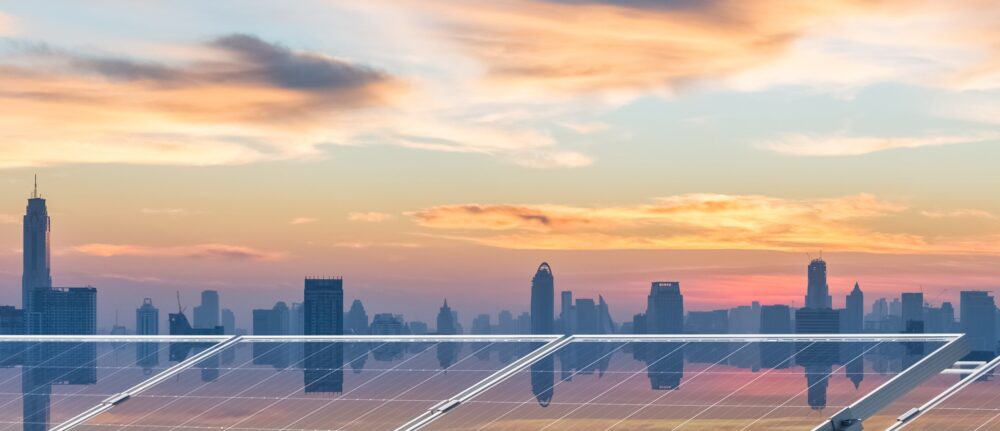Subsea cable interconnector projects: an introduction to risks and opportunities
15 September 2022
As governments work towards their climate goals and traditional sources of energy are replaced by renewable ones, energy infrastructure is increasingly moving offshore. Offshore solar and wind projects provide examples of a growing trend, with other nascent ocean energy technologies quickly emerging. Alongside power generation, appropriate deepwater transmission infrastructure will be required to export clean energy across long distances between countries and continents.
Offshore power generation and transmission will require long-term, capital-intensive investments in state-of-the-art infrastructure. This can only be efficiently delivered if there is both trust and transparency in how projects are regulated and risks shared – particularly when it comes to the development of infrastructure beyond areas of national jurisdiction.
Submarine power transmission systems (also referred to as ‘interconnectors’) consist of high-voltage direct current (HVDC) submarine cables, which are today a mature technology with an approximate 10,0000 km of cables cumulatively in service worldwide.[1] In Australia, the Basslink interconnector has been in service since 2006, linking the Tasmanian and Victorian grids. Presently, the longest interconnectors globally are in the construction phase, including the EuroAsia Interconnector (a 3,200 km HVDC cable connecting the grids of Israel, Cyprus and Greece) and the North Sea Link (a 720 km subsea HVDC cable connecting the UK and Norway grids).
Below, we explore some of the key issues the proponents of submarine interconnector projects should bear in mind, including:
- the recently introduced legislative framework governing offshore energy transmission infrastructure in Australian Commonwealth waters and the regulatory framework governing power transmission beyond areas of national jurisdiction;
- the main technical and legal risks involved in creating and operating transnational interconnectors; and
- strategies for effective risk allocation and management.
Regulatory frameworks governing offshore energy transmission
Submarine cables within Australian waters are governed by a combination of Commonwealth and state and territory legislation. In June 2022, the Offshore Energy Infrastructure Act 2021 (Cth) (OEI Act) came into force, introducing a new licensing regime applicable to fixed and floating offshore renewable energy generation and transmission infrastructure located within Commonwealth waters. That regime applies alongside others, including those under the Environment Protection and Biodiversity Conservation Act 1999 (Cth) (EPBC Act), and state or territory frameworks in circumstances where the transmission infrastructure traverses coastal waters (the first three nautical miles from the coastline).
Pursuant to the OEI Act, the installation and operation of submarine cables in Commonwealth waters now requires a transmission and infrastructure licence to be granted by the Federal Minister for Climate Change and Energy. A licence is subject to compliance with regulatory requirements, conditions and a management plan, which must be developed and periodically updated by the licensee. The management plan details how the project will operate to ensure, among other things, that environmental and marine users’ interests are protected.
Regulations made under the OEI Act, which are presently available in draft form, will provide details on a number of key issues, including the criteria for granting a license under the Act. The OEI Act and draft regulations contemplate a number of merits criteria applicants will need to meet, including:
- a demonstration of adequate technical and financial capability;
- a project’s commercial viability (including project costs and returns, and key upstream and downstream supply chain participants); and
- an applicant’s suitability (including the applicant’s corporate governance and compliance history).
Further, according to the draft regulations, the impacts of the proposed project are also to be assessed, including impacts on Australia’s national interest, on security and on existing users of the licence area.
In the circumstances where the project will impact on matters of national environmental significance within the Commonwealth seabed area (3 to 200 nautical miles off the coastline of Australia) – for example, Commonwealth-listed threatened marine species – then the proponent must refer the action to the Commonwealth Department of Climate Change, Energy, the Environment and Water (DCCEEW) for assessment as to whether the action is a ‘controlled action’ requiring approval under the EPBC Act. The Offshore Renewables Environmental Approvals guidance note recommends obtaining the EPBC Act approval prior to applying for the transmission and infrastructure licence.
The conditions of both the EPBC Act approval and transmission and infrastructure licence will support the preparation of any management plan that will be approved by the Regulator of the OEI Act.
The laying of submarine cables within and beyond Commonwealth waters is also governed by the UN Convention on the Law of the Sea (UNCLOS). Pursuant to UNCLOS, in maritime areas outside of coastal states’ territorial seas (extending up to 12 nautical miles from coastline), all states enjoy the freedom to lay, maintain and repair submarine cables.[2] While referred to as a ‘freedom’, the rights are not absolute – they are limited by the rights exercisable by coastal states within their declared Exclusive Economic Zone (EEZ) and continental shelf (such as to exploit their natural resources), and other uses (or ‘freedoms’) of the seas exercisable by all other states (such as the freedom of navigation). To the extent submarine cables traverse a coastal state’s EEZ or continental shelf, the exercise of the freedom to lay cables is subject to a number of obligations. These include obligations to have ‘due regard’ to the rights and duties of the coastal state and the cables or pipelines already laid in the area,[3] and to comply with the laws and regulations governing those areas, which the coastal state may adopt pursuant to UNCLOS. Conversely, coastal states have the right to take ‘reasonable measures’ to explore and exploit natural resources within their continental shelf boundaries,[4] although such measures cannot unreasonably impede the exercise of other states’ freedom to lay or maintain submarine cables.
In waters regulated by UNCLOS, environmental impact assessments are required to be prepared. The United Nations Intergovernmental Conference on Marine Biodiversity of Areas Beyond National Jurisdiction is finalising an international legally binding instrument under UNCLOS which will increase assessment requirements in respect of marine sustainability.[5]
Risks associated with offshore energy transmission infrastructure
Submarine power cable technology has become increasingly more sophisticated over recent decades, but the risk of cable damage and interruption in service remains high. Empirical data shows that most instances of submarine cable damage are caused by external human events such as the dropping of fishing gears, anchors or other dropped objects. These risks are higher in shallower waters. Physical damage can also occur where submarine cables intersect other submarine infrastructure including power and communications cable systems and gas pipelines. Other causes of cable damage include complex submarine conditions and environmental factors, including ocean currents, heat waves and thermal stress, and events such as tsunamis, seismic activities and chemical corrosion. Seabed depth variation and slope gradients present their own set of risks, such as the risk of sediment movement triggered by earthquakes and turbidity currents.
These risks underscore the importance of undertaking detailed geotechnical and seabed surveys during the feasibility stage of a project to determine the appropriate route of the cable and develop an understanding of the seabed topography. The charting of the route amounts to a risk assessment exercise, as it seeks to avoid hazards to the infrastructure due to the geomorphology of the seabed, as well as environmentally significant zones.
Submarine power cables are laid offshore by specially designed ‘cable laying vessels’ (or ‘CLVs’). CLVs can carry only a certain length of cable per shift and may require several trips back to the manufacturing facility to complete cable installation, any of which may be affected by factors such as weather conditions and restrictions imposed to protect marine life.
The laying of a cable in deepwater presents additional challenges. While the risk of cable damage from external human events is lower (for which reason cables in deep waters are typically surface-laid and not buried), the operation is significantly more complex and cables are often damaged during installation. The repair of cables in deepwater sections is also more challenging. Repairs are done on vessels offshore and ultimately result in additional length of cable being installed. Repairing a section of cable typically requires that a corridor of a sufficient width be available on either side of the cable route for the replacement cable to be laid (typically perpendicular to the initial cable route).[6]
As with other major projects, environmental approvals are a key component of an interconnector project and may take significant time to be prepared, assessed and approved. This is particularly so given the overlay of UNCLOS, the EPBC Act and state and territory environmental laws, which will require a significant degree of coordination. A key focus of the assessment process involves the risk of cable operations disturbing the marine environment, including reefs and other fragile ecosystems. Heat loss and physical disturbances in certain marine areas may also require closer analysis of the cumulative impacts on the environment and as a consequence, may attract environmental approval conditions to mitigate and manage this issue. The State of New York commissioned an Environmental Sensitivity Analysis for offshore wind projects to inform a Masterplan. The analyses identified receptors, i.e. fish and turtles, and the stressors on these receptors during each stage of the project process, which informed a sensitivity model. These types of sensitivity analyses could be required in Australia when seeking an environmental approval for any type of infrastructure located within the marine environment. Any such analyses would support transparency around environmental impacts in Australian waters, particularly if there is a proliferation of these types of projects.
Relevantly, assessment and reporting on cumulative environmental impacts are key recommendations of the Final Report of the Independent Review of the EPBC Act (released October 2020) (Samuel Review) with the new Federal Labor Government refocusing its attention on the recommendations as part of a wider federal environmental reform agenda.
Another aspect of offshore development that requires a significant degree of trust and transparency is the co-existence of marine infrastructure with native title rights and the rights of First Nations people. There is likely to be an increased focus on upfront engagement with First Nations people when developing major infrastructure projects in the future, and an emphasis on obtaining free, prior and informed consent (or FPIC).
The foregoing risks and challenges are exacerbated in the case of transnational interconnectors due to the fact that cable repair activities must be undertaken in areas under the jurisdiction of a foreign state. Particular problems can arise where the cable passes through areas designated for the development of hydrocarbons, as oil and gas exploitation is prioritised by coastal states over cable infrastructure. In some instances, cable owners have had to compensate a hydrocarbon concessionaire in order to be able to transit the area covered by the concession.[7]
Further risks involve a possible withdrawal of necessary permits or licenses due to non-compliance with regulatory requirements or marine damage, a failure by the coastal state to use statutory means to protect the cable route or the coastal state’s failure to exercise due diligence to prevent cable damage by third parties. Politically-inspired events and governmental actions adopted by the coastal state may also have a material adverse effect on the operation of an interconnector, interfere with cable repair operations, or otherwise hamper the continued operation of the cable.
Risk management and sharing
How are the risks associated with offshore energy transmission infrastructure to be shared and managed? Proponents of submarine interconnector projects should bear in mind the following key issues:
- Projects of this nature require a satisfactory revenue stream. Accordingly, the power purchase agreement (PPA) is of fundamental economic importance. From the purchaser’s point of view, the reliable delivery of power is also essential. The risk of outages (both planned and unplanned) needs to be dealt with comprehensively in the PPA. Consideration should be given to whether the project owner must have at all relevant times ships and other equipment necessary on standby to rectify any damage to the cable as quickly as possible (and in locations proximate to the interconnector route). It is common for the PPA agreement to deal with this expressly. The intention is to minimise disruption to both the purchaser of the power and to the revenue of the project owner. Consideration also needs to be given to the extent of force majeure relief in circumstances additional to the environmental and other usual force majeure events discussed below.
- Cable protection typically requires the balancing of various interests and risks. To protect against physical damage, submarine cables are typically buried under the seabed (typically 1.6 – 1.5m deep) in shallower waters, which requires specific equipment. Cable protection at the point of cable or pipeline crossing requires additional protective measures which may be provided by installing protective structures such as rock or concrete mattresses.[8] Deep cable burial, while potentially being more secure, can also harm the cable by reason of temperature rise and corrosion from the seabed.[9]
- Crossing agreements may need to be entered into. Where submarine cables cross other submarine infrastructure, it is common for the operators to enter into crossing agreements which define mutually capped indemnities against damage caused by the other party’s operations. Thus, for example, if pollution is caused due to a power cable damaging a pipeline, liability as between the pipeline and cable owners will typically be determined under the crossing agreements between them.
- The specific risks in play require a careful negotiation of the contractual risk allocation, as well as appropriate insurances. Consideration should be given to contractual risk sharing or transfer to the party best placed to manage the risk, in particular in respect of environmental and third party events that may impact the cable. There will usually be relief or force majeure events negotiated into the contractual arrangement which provide for risk sharing in the event that the cable cannot operate for a period due to environmental events external to the project. As noted, responsibility for damage caused by competing uses of the sea floor may be dealt with in the crossing agreements between submarine infrastructure owners.
- Contractual environmental liabilities should be clearly identified, including with respect to enforcement action for environmental incidents, breach of environmental approvals and decommissioning requirements. There are a number of regulators that may be involved in any such enforcement action including National Offshore Petroleum Safety and Environmental Management Authority (NOPSEMA), state and territory environment protection authorities and, in the future, a Federal environmental protection agency (which is yet to be established but is one of the proposals under the Federal Government’s environmental reform agenda).
- The program of works and risk allocation should account for the specific risks of delay involved in offshore cable laying and operation. These risks include potential delays resulting from (for example) permit processes, weather conditions, the availability and capacity of material and machinery (including CLVs), transport, cable damage or unilateral adverse actions of a coastal state government.
- Where the interconnector traverses the jurisdiction of several states, successful and continuous engagement with the coastal state with prescriptive and enforcement jurisdiction over the relevant maritime areas will be critical to ensure the long-term success of the project. The cable owner may require permits or authorisations from the coastal state for the surveying and laying, maintenance and repair of submarine cables. The coastal state can alter or implement laws that impact the operation and maintenance of the cables, or restrict cable maintenance or repair activities. Political risk insurance and protections available under investment treaties should be explored to ensure that the cable owner is protected against the political risks involved when operating in a foreign jurisdiction. Ideally, there should be an investment treaty in force between the home state of the cable owner and each coastal state along the cable route. The treaty should have provisions that allow the cable owner to seek compensation from the coastal state before an independent panel of arbitrators in the event of any adverse acts or omissions by the coastal state that might impede the laying, maintenance or repair of the submarine cable. In considering the best available treaty protections, consideration must be given to the territorial scope of any applicable treaties and, in particular, whether the relevant treaty applies to the trajectory of the cable through maritime areas under the costal state jurisdiction.[10]
***
The foregoing overview provides but a sample of risks and challenges project owners will need to account for in developing contracting strategies and risk mitigation tools to effectively deliver submarine interconnectors.
The best contracting strategy will ultimately depend on a combination of factors, including (but not limited to) a project’s individual characteristics, cable length and the water depth along the cable route, the relevant coastal jurisdictions and the political risk of operating within those jurisdictions. This will require a holistic assessment a project’s risk profile, and unique and innovative approaches to project planning, financing and delivery.
[1] J Gordonnat and J Hunt, Subsea cable key challenges of an intercontinental power link: case study of Australia-Singapore interconnector, Energy Transitions (2020) 4:169-188, 170.
[2] This is also referred to as one of the defined ‘freedoms of the high seas’. The freedom does not apply within a coastal state’s territorial sea, internal waters or archipelagic waters.
[3] UNCLOS Articles 58(3) and 79(5).
[4] UNCLOS Article 79(2).
[5] See generally the work of the Intergovernmental Conference on an international legally binding instrument under UNCLOS on the conservation and sustainable use of marine biological diversity of areas beyond national jurisdiction (General Assembly resolution 72/239).
[6] J Gordonnat and J Hunt, Subsea cable key challenges of an intercontinental power link: case study of Australia-Singapore interconnector, Energy Transitions (2020) 4:169-188, 177.
[7] Y van Logchem, Submarine Telecommunication Cables in Disputed Maritime Areas (2014) 45 Ocean Development & International Law 107, 109.
[8] J Gordonnat and J Hunt, Subsea cable key challenges of an intercontinental power link: case study of Australia-Singapore interconnector, Energy Transitions (2020) 4:169-188, 175.
[9] W Wang, X Yan, S Li, L Zhang, J Ouyang and X Ni, Failure of submarine cables used in high-voltage power transmission: Characteristics, mechanisms, key issues and prospects 2021 (15) IET Generation, Transmission & Distribution 1387, 1397.
[10] For further detail on the territorial scope of investment treaties see ‘Investment in disputed territories: lessons for investors’, published 4 August 2022, available: https://www.corrs.com.au/insig...
Authors

Head of Projects

Head of Environment and Planning

Head of Arbitration
Tags
This publication is introductory in nature. Its content is current at the date of publication. It does not constitute legal advice and should not be relied upon as such. You should always obtain legal advice based on your specific circumstances before taking any action relating to matters covered by this publication. Some information may have been obtained from external sources, and we cannot guarantee the accuracy or currency of any such information.
Key Contacts
Head of Environment and Planning
Related Capabilities
- Arbitration
- International Arbitration
- Projects and Construction Arbitration
- Energy and Natural Resources
- Environment and Planning
- Infrastructure Delivery
- Projects and Construction
- Construction and Infrastructure Projects
- Energy and Natural Resources Projects
- Environmental Compliance and Regulation
- Responsible Business and ESG




